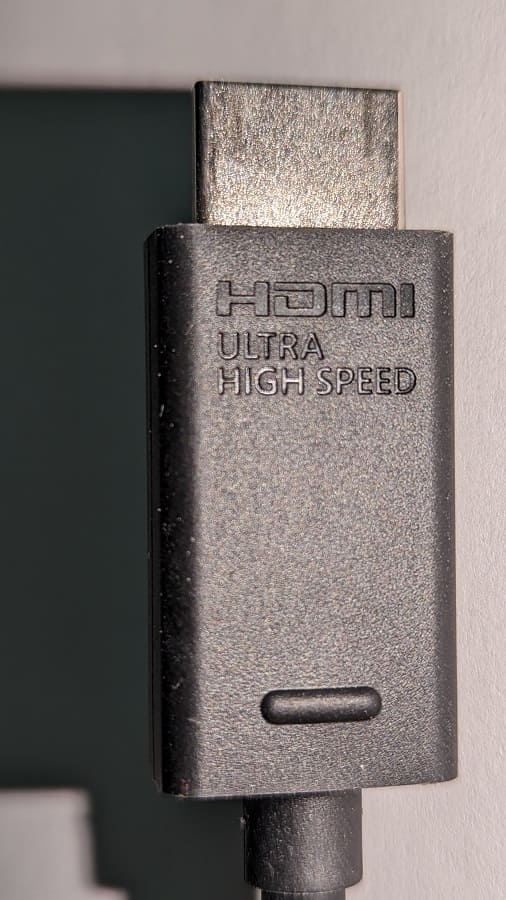In order to get the most out of your LG A3, B3 or C3 television set, you should make sure that you are using the correct HDMI cable to connect your media player, game consoles and other external devices. You can check out this guide at Seeking Tech to see which HDMI cables are compatible with these 2023 OLEDs.
What HDMI ports are included with the LG A3?
The LG A3 comes with three HDMI 2.0 ports.
With that said, you can still connect an external device by using a HDMI 2.1 cable to this television set. However, the bandwidth will be limited to 18.0 Gb/s and you won’t be able to take advantage of HDMI 2.1 features such as Display Stream Compression (DSC) 1.2a and Enhanced Audio Return Channel (eARC).
What HDMI ports are included with the LG B3?
The LG B3 comes with two HDMI 2.0 ports as well as two HDMI 2.1 ports.
As we stated previously, you can still use a HDMI 2.1 cable to connect to HDMI 2.0 port although you will be limited to HDMI 2.0 bandwidth speeds and features.
What HDMI ports are included with the LG C3?
All four HDMI ports of the LG C3 OLED television set are HDMI 2.1. While you can use older HDMI cables, the bandwidth will be limited and, as a result, you will miss out on some of the more advanced features of this television set.
How to identify HDMI cable types
You should be able to tell the HDMI cable type by looking at the labels of your cable. Some cables may have the version number or bandwidth specs printed directly on them.
You may also be able to look up the name of your cable as the first-generation cables are called HDMI Cable while the second-generation is named HDMI High Speed. The third-gen release is referred to as HDMI Premium while the latest version is titled HDMI Ultra High Speed.

You can find a list of compatible HDMI cable types for the LG A3, B3 and C3 OLEDs below:
- HDMI 1.0 (HDMI Standard): 4.95 Gb/s bandwidth
- HDMI 1.1 (HDMI Standard): 4.95 Gb/s bandwidth
- HDMI 1.2 (HDMI Standard): 4.95 Gb/s bandwidth
- HDMI 1.3 (HDMI High Speed): 10.2 Gb/s bandwidth
- HDMI 1.3a (HDMI High Speed): 10.2 Gb/s bandwidth
- HDMI 1.4 (HDMI High Speed): 10.2 Gb/s bandwidth
- HDMI 1.4a (HDMI High Speed): 10.2 Gb/s bandwidth
- HDMI 2.0 (HDMI Premium): 18.0 Gb/s bandwidth
- HDMI 2.0a (HDMI Premium): 18.0 Gb/s bandwidth
- HDMI 2.0b (HDMI Premium): 18.0 Gb/s bandwidth
- HDMI 2.1 (HDMI Ultra High Speed): 48.0 Gb/s bandwidth
HDMI Length Requirements
LG recommends that you use an HDMI cable that is no longer than 9.84 feet (or 3 meters) for the A3, B3 and C3. If you use a longer length, then you may experience problems such as input lag, audio delay or a blank screen.
HDMI Bezel Size
The bezel, which is the blocky end in between the cable and connector, should be less than 0.39 inches (or 10 mm) thick and less than 0.7 inches (or 18 mm wide). If the bezel is larger than the aforementioned maximum limits, then you may not be able to plug the HDMI connect all the way in.
If you want to connect a streaming stick to your television set, then you should make sure that it is less than 0.39 inches thick and less than 0.7 inches wide. Otherwise, you may need to get an extension cable in order to fit it in the HDMI port of your OLED screen.
Recap
Overall, we recommend getting a HDMI 2.1 cable that is less than 10 feet in length for all three of these television sets.
Although the LG A3 is only equipped with HDMI 2.0 ports, it should be compatible with the HDMI 2.1 cable. Not to mention that, if you decide to upgrade from the A3 to a newer TV with HDMI 2.1 ports in the future, you won’t have to worry about getting a new cable.
If you are having a difficult time identifying which HDMI 2.1 cable to get, then we recommend picking up the Zeskit Maya 8K 48Gbps Certified Ultra High Speed HDMI Cable. You can find this product on Amazon with this link. (#CommissionsEarned).

